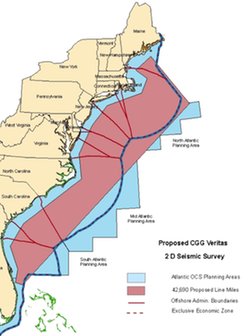US east coast seismic survey EIS draft released
Effects of Noise on Wildlife, News, Ocean, Seismic Surveys Add commentsThe US Bureau of Ocean Energy and Management (BOEM) has released the Draft Programmatic Environmental Impact Statement that is the first step toward oil and gas development off the east coast. The PEIS assesses the impacts of geological and geophysical (G&G) activities, primarily seismic surveys and test wells.
 I’ve yet to dig into the PEIS to examine its alternatives or proposed mitigation measures, but a quick look at maps illustrating applications already received from oil and gas exploration companies affirms that the entire east coast could become an active seismic survey zone (the map at left is one of nine applications; there is much overlap among them).
I’ve yet to dig into the PEIS to examine its alternatives or proposed mitigation measures, but a quick look at maps illustrating applications already received from oil and gas exploration companies affirms that the entire east coast could become an active seismic survey zone (the map at left is one of nine applications; there is much overlap among them).
UPDATE, 3/30/12: While those maps look impressive, both the International Association of Geophysical Contractors and the American Petroleum Institute have issued statements that surveys are unlikely to take place until the path opens for actual leases to be issued; the decision was already made to not issue any Atlantic leases during the current 2012-2017 planning period. The applications for surveys currently on file were submitted during a period in 2008 when a long-standing Presidential order excluding oil and gas development on the Atlantic coast was lifted. “Without an Atlantic coast lease sale in their five-year plan, theadministration’s wishful thinking on seismic research has no ultimate purpose,” said Erik Milito, upstream director at API. Chip Gill, IAGC President, stressed that “contrary to the statements [by US Interior Sec. Ken Salazar and BOEM Director Tommy P. Beaudreau], we do not expect seismic surveys to be conducted for years, and thus we don’t expect it to be available to help the federal government evaluate the resource base anytime soon.”
(and now back to our original post):
While very few animals are killed or injured by air gun sounds, behavior can be affected for tens of miles, and airgun sound can be heard (and so drown out some distant communication) for hundreds of miles. I just returned from a BOEM workshop on the effects of ocean noise on fishes and invertebrates, where scientists shared research on reduced fish catch rates near surveys (the fish move away for a few days or weeks, then gradually return), and attempted to come up with a shared understanding of how to investigate whether ocean noise can affect fish communication, larval or egg development, or other aspects of ocean ecology (so far, there is little direct evidence of impacts, but some concern remains about masking of sounds fish use for many purposes, and the possible negative stress impacts of chronic noise exposure).
From looking at the maps of existing applications to do surveys (download pdf of rough maps of all 9 applications), it’s immediately apparent that BOEM could work to minimize duplicating of efforts by several companies. It may be that there will be areas that are clearly inappropriate for oil and gas development (eg, key fishing grounds or other biologically important areas), or seasonal exclusions to reduce impacts on spawning or migration.
Of course, there’s also the bigger-picture climate change question of whether we really want to be continuing to pull more oil and gas from the ocean in the years after 2020 anyway; any new leases will be issued after 2017, with development following years later. Meanwhile, BOEM is working hard to lay the groundwork for renewable energy development in offshore waters, targeting areas for wind, tidal, and wave energy systems. For now, continuing to plan for oil and gas development is part of the Obama administration’s “all of the above” approach to meeting America’s future energy needs.
For more on the Draft PEIS, see BOEM’s PEIS website, which includes links to download the documents and submit comments, this press release from the Department of the Interior, and this blog post from NRDC (which stresses that quieter alternative technologies for oil and gas exploration are expected to be commercially available in 3-5 years).

April 1st, 2012 at 1:11 pm
It becoming quite clear(research and testing) that the high pressure natural gas lines running everywhere, are emanating ILFN causing the strange hum phenomena and impacting us and wildlife species.